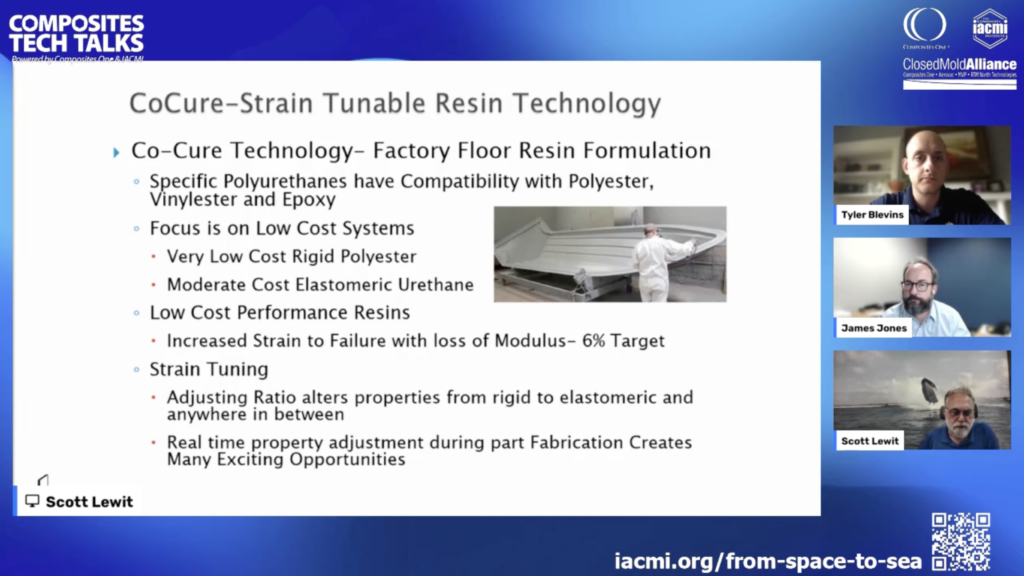News
CoCure Technology Innovation by Structural Composites Transforms Industry Applications

Composites One hosted a live LinkedIn Composites Tech Talks with IACMI and Structural Composites to present a case study on how composites are changing the way companies make parts. Structural Composites explained how it has used government and commercial research funding to create and deploy innovation hybrid composites technology solutions for marine, defense, transportation, and infrastructure applications.
Marine innovations
Structural Composites leveraged Small Business Innovative Research (SBIR) funding to answer the need of the Navy for a combatant craft that was easier to build and maintain, lighter weight, and more affordable. Structural Composites embarked on building a lower cost, lightweight, shock-mitigating boat to improve ride quality in the marine defense segment. To this end, the company formulated a CoCure marine gel coat that married polyester resin with polyurethane to maximize elongation and flexibility in the shock mitigating boat.
Using marine as a technology development bed to drive technology in other markets, Structural Composites leveraged the CoCure technology, altering the resin and fiber inclusion to increase properties like abrasion resistance, and applied the technology for other high-functioning industry applications.
Structural Composites set its sights on entering exclusive relationships with manufacturers in industries that could be revolutionized with composites, focusing on markets that have less composites penetration with more cost and performance barriers, such as transportation and construction. The goal was to drive the same level of composite innovation as is seen in industries like marine that have wide adoption and minimal barriers to entry.
Transportation innovations
Structural Composites furthered its experience with marrying materials with different properties for a technology-sharing initiative to create a CoCure hybrid technology metal that combined composites and metal to be used in place of conventional bonding. By changing the CoCure formulation from a coating to an adhesive, and from a non-stick to a stick solution, the resulting sticky product could be sprayed directly onto metal surfaces to laminate the metal.
Using the CoCure technology, Structural Composites and Wabash National created a hybrid metal-composite van that would be road certified in less than a year. The lighter, game-changing van would break load capabilities to expand possibilities for Wabash customers.
Features of the CoCure hybrid metal/composite technology include:
• Allowing composites to be fabricated on metals and not post-bonded
• Making excellent connection between metal and low-cost polyester composite
• Allowing parts to be post-shape formed
• Enabling metals to be shaped and laminated
Using the CoCure technology developed with the Navy and enhanced with the Wabash partnership, Structural Composites reengaged in the marine market and delivered to the Navy a single inboard watercraft at 4,600 lbs. – previously a 5,600 lb. boat – with weight savings in the hull, deck, and console fabricated through open mold processing.
Infrastructure innovations
CoCure also impacted advancements in infrastructure, with the successful installation of the state of Tennessee’s first composite bridge in a rural community. The fiber-reinforced polymer bridge deck replaced a damaged concrete crossing that was structurally deficient and outdated. The solution had critical features of an extensive highway bridge deck, made of two high-strength, 8’x25’x9’ ¼” panels that were significantly lighter than reinforced concrete with superior corrosion resistance. The composite bridge decks were prefabricated offsite and installed in just one day to reduce downtime, energy costs, and on-site construction costs. The composite deck systems offered a sustainable solution for aging bridges and infrastructure.
To learn more about the industry applications of the CoCure hybrid metal/composite technology, watch the LinkedIn Live Composites Tech Talks here.

